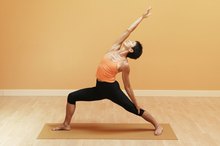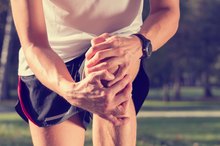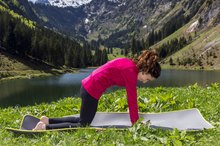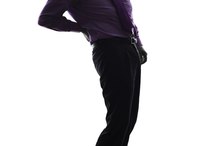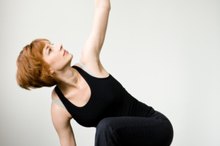Physical Therapy Exercises for Abdominal Adhesions
An adhesion is another name for scar tissue. Abdominal adhesions most commonly form following abdominal surgery but can also be caused by inflammation related to appendicitis or infection in your organs. This scar tissue can be painful, causing you to experience cramping and even intestinal obstruction.
If you experience abdominal adhesions, you can use physical therapy exercises to relieve symptoms and soften scar tissue. Obtain permission from your physician before beginning a stretching program to ensure you can stretch safely.
Cobra Pose
The cobra is a yoga pose that is very effective in stretching the abdominal wall. Begin by lying on your stomach, with your hands at your shoulders, palms facing down.
Push your hands against the floor to lift your upper body. Your hipbones and pelvis should remain on the ground. Avoid letting your shoulders rise toward your earlobes.
Take a few deep breaths as you feel the stretch in front of your abdomen and lower back. Hold for 15 to 30 seconds, and repeat three times.
- The cobra is a yoga pose that is very effective in stretching the abdominal wall.
- Push your hands against the floor to lift your upper body.
Side Twists
Yoga Spine Alignment
Learn More
Twisting stretches can stretch your adhesions from a different angle. You can perform this stretch while seated or standing. Hold your arms out to your sides at shoulder height, with your palms down. Maintain your arms at shoulder level as you twist to your right, putting the left hand forward and right arm backward. Take deep breaths as you feel the stretch in your abdomen.
Hold this position for 15 seconds, then rest and alternate to your opposite side. Repeat three times for each side.
- Twisting stretches can stretch your adhesions from a different angle.
- Take deep breaths as you feel the stretch in your abdomen.
Cat/Cow Stretch
The cat/cow exercise gently massages your abdominal walls to facilitate abdominal stretching. Begin on all fours, with your back straight and pelvis tucked slightly in.
Slowly arch your back and round your shoulders to create a C-curve -- like a cat with its back arched -- in the spine. Hold this position for 10 seconds.
Release the stretch to lower the back, creating a reversed U shape with your back. Your head should look forward.
Hold for 10 seconds, then release the stretch. Repeat the cat/cow position three times through.
- The cat/cow exercise gently massages your abdominal walls to facilitate abdominal stretching.
- Release the stretch to lower the back, creating a reversed U shape with your back.
Supta Virasana
Exercises for Contracted Muscles Behind the Knee
Learn More
For more advanced exercisers, the supta virasana, or reclining hero pose, stretches the lower pelvic region. Start by kneeling, with your hands at your sides.
Slowly lower your buttocks toward the ground while moving your feet outward until you are seated.
Lean backward, and place your hands on the ground, walking them back until your entire torso is on the ground. You may wish to place a rolled-up towel or bolster pillow under your back for support. Hold your arms at your sides with your palms facing up as you stretch and breathe deeply. Remain in this position for one to five minutes. Use your arms to push your torso up, and then unfold your legs.
- For more advanced exercisers, the supta virasana, or reclining hero pose, stretches the lower pelvic region.
- Use your arms to push your torso up, and then unfold your legs.
Related Articles
References
- "Abdominal Vacuum Lift as an Aid to Diagnosing Abdominal Adhesions"; Julius Strauss; Massachusetts Institute of Technology; June 2006
- Yoga Journal: Yoga After an Abdominal Hysterectomy
- Yoga Journal: Cat Pose
- Yoga Journal: Reclining Hero Pose
- MyFit.ca: Abdominal Twists -- Dynamic Stretch Exercises
- Lurati AR. Health issues and injury risks associated with prolonged sitting and sedentary lifestyles. Workplace Health Saf. 2018;66(6):285-290. doi:10.1177/2165079917737558
- Nakphet N, Chaikumarn M, Janwantanakul P. Effect of different types of rest-break interventions on neck and shoulder muscle activity, perceived discomfort and productivity in symptomatic VDU operators: A randomized controlled trial. Int J Occup Saf Ergon. 2014;20(2):339-53. doi:10.1080/10803548.2014.11077048
- Cooley D, Pedersen S. A pilot study of increasing nonpurposeful movement breaks at work as a means of reducing prolonged sitting. J Environ Public Health. 2013;2013:128376. doi:10.1155/2013/128376
- Daneshmandi H, Choobineh A, Ghaem H, Karimi M. Adverse effects of prolonged sitting behavior on the general health of office workers. J Lifestyle Med. 2017;7(2):69-75. doi:10.15280/jlm.2017.7.2.69
- Henning RA, Jacques P, Kissel GV, Sullivan AB, Alteras-Webb SM. Frequent short rest breaks from computer work: Effects on productivity and well-being at two field sites. Ergonomics. 1997;40(1):78-91. doi:10.1080/001401397188396
- Ylinen J, Kautiainen H, Wirén K, Häkkinen A. Stretching exercises vs manual therapy in treatment of chronic neck pain: A randomized, controlled cross-over trial. J Rehabil Med. 2007;39(2):126-32. doi:10.2340/16501977-0015
Writer Bio
Rachel Nall began writing in 2003. She is a former managing editor for custom health publications, including physician journals. She has written for The Associated Press and "Jezebel," "Charleston," "Chatter" and "Reach" magazines. Nall is currently pursuing her Bachelor of Science in Nursing at the University of Tennessee.
